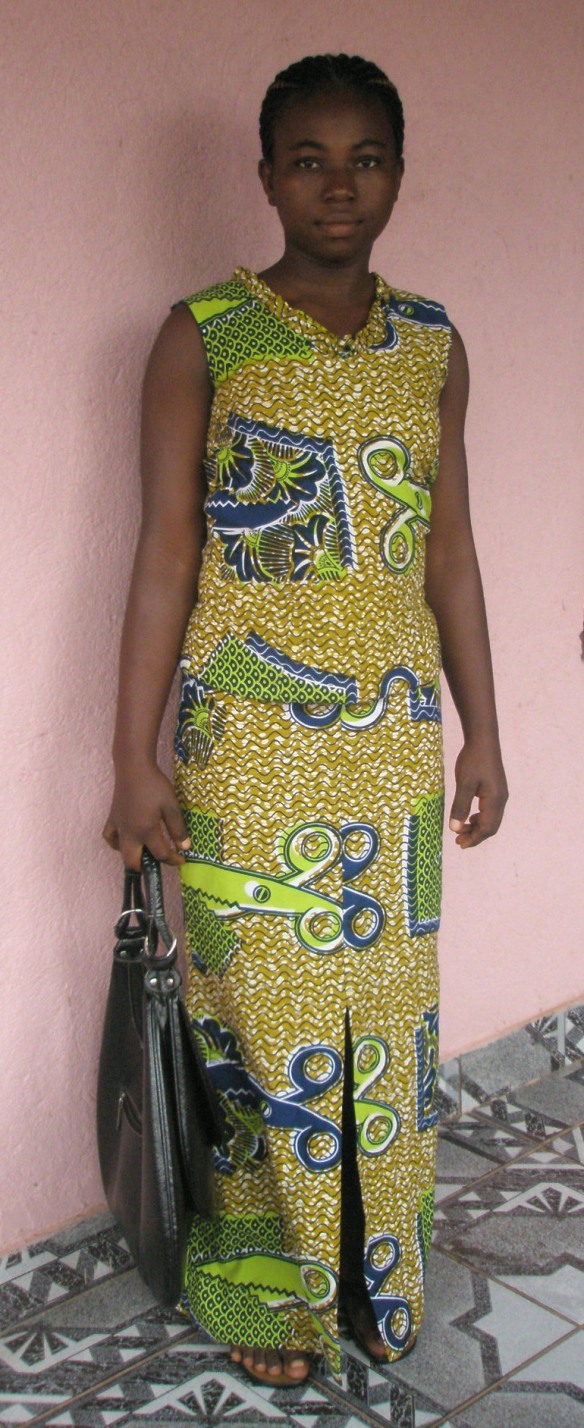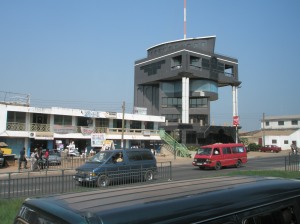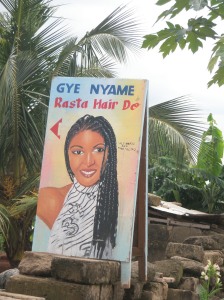It’s customary in my culture to recognise transitions or achievements with awards. So I think it’s fitting to mark my transition from Ghana back to Australia with some special awards in a range of categories. Among other things, my awards point to the various consequences of poverty and under-development, the innovation and creativity that springs up in the face of adversity, and how what’s culturally acceptable in Ghana can be very confronting to a non-Ghanaian. I’m sorry, not all of them are nice. But some of them are.
I’ll start on a positive note.
The Golden Cocoa Pod for Sales Innovations goes to:
The young man selling thongs (flipflops) outside Korle Bu Hospital in Accra. The thongs, with light brown soles and fluoro … ummm …. thong bits …. were attached to a large cardboard box exactly the same colour as the soles, with the toe end sticking up over the top of the box so that from a distance, it looked like an exotic multi-eared head-dress. Eye-catching, colour-co-ordinated, lightweight and practical. Well done.
For Optimism In Spite of Everything
Everywhere in Ghana you see small plywood cubicles, often no more than one metre square, usually painted some combination of yellow, red and green. The vendors at these cubicles sell lottery tickets. My Optimism Award goes to one such cubicle, spotted on the Sunyani Road on my way to Mensakrom, which was called Mappi Ventures. Venture is a word I associate with much grander enterprises. Anyone who can call a box that size a venture deserves full encouragement and recognition, especially in the current global economic climate. Unless it’s really a Tardis. May you get the winning ticket and a mansion on the Gold Coast (the Australian Gold Coast, that is).
For a Fantastic Place Name
I love words as you’ve probably guessed and I love the place names in Ghana. Kwadaso, Tanaso, Patasi, Odumasi, Abwakwa, Nkawkaw, Nsawam, Dansoman, Mamprobi, Akosombo, don’t they just role off the tongue? There were many competitors for this award but only one obvious finalist. Ododododidioo, in Accra, congratulations on your polysyllabic glory, and I apologise if I didn’t put in the right number of ‘do’s.

- Scissor design
For Moving With The Times
If you have been following this blog you may have got a hint by now that Ghana is a good place to visit if you are a textileophile. Every day you can feast your eyes on an array of gorgeous fabrics: tie-dyed, wax (batik), block printed, woven, or embroidered in a multitude of colour combinations. One of the reasons the fabrics interest me is because they are not only beautiful, but many are full of meaning. Textiles in Ghana are on the front line of non-verbal communication. DadaK told me years ago that a woman could insult someone else in her household just by wearing a particular pattern, and that an adinkra symbol was banned as seditious at one time during the military Rawlings regime. Adinkra and Kente have been around a long time, but contemporary designers are still inspired by them and use them in new designs.
I asked Dr Esi Sutherland, a presenter at the Our Media Conference in Accra, if these days the power of adinkra was being eroded by modernity and western influence, and the symbols were becoming merely decorative. My family, for example, could identify only the best known and most commonly used, such as Gye Nyame, which is everywhere. She answered that it was true that was happening, but when it was really important, for example at a funeral, people knew what symbols to wear. (The conference itself included an adinkra symbol in its logo). She also said that new symbols were being invented all the time, although strictly speaking they weren’t adinkra. So perhaps obaapa, which I haven’t seen on any adinkra lists, comes into this category.
It was while in Accra for the conference that I saw the cloth that will be receiving the Golden Sewing Machine for proving to me that although times are changing, the power of textile symbolism is still strong in Ghana. The Award goes to the shirt I spotted from a traffic jam in Jamestown. The man wearing it was moving much faster than the traffic, and I only saw him from behind so I don’t have a photo. The cloth had a rusty red squiggly background that is popular in a lot of Ghanaian wax cloth, with dark blue circles framing the main icon: a computer mouse. This circling of images is also a common feature of Ghanaian cloth and is frequently used in uniforms, from school children to bank employees. The circled item is often a logo accompanied by text, e.g. the name of the school. But this shirt just had a computer mouse. No words. So until I see it again – if I ever do – it’s a mystery as to why it existed. But it does. And if the design were to persist, I wonder what meaning it would accumulate over coming centuries. I want that Tardis now!

Accra commercial architecture
Magnificent architecture
It appears to me that Ghanaian architects know no fear. They don’t fear asymmetry, unorthodox designs, unsupported flooring or even roofs the size of tennis courts. There is a lot of housing development going on in Ghana – much of it, I assume, funded by the money sent back by expatriates such as DadaK (I’m told it’s the third biggest earner for Ghana, after gold and cocoa). The part of Asuoyeboah where we lived was known as a new development and few buildings would have been more than twenty years old.
DadaK started building over fifteen years ago, I saw the foundations on my first visit to Ghana in 1993, so our place is rather conventionally laid out, but others in the area are far more flamboyant. Apart from all being made of concrete blocks and having lots fancy metal security grilles, they bear little in common other than size (they are built to accommodate large extended families) and a sense of adventure. It really looks like Ghanaian architects and home owners have jointly decided to play. Unusual shaped walls and verandahs frame eccentrically shaped spaces. It’s hard to tell what design influences inspire these fabulous buildings, they don’t seem particularly related to traditional designs or to earlier, more traditional housing. Perhaps it is the influence of expatriates who’ve travelled the world and come back with novel interpretations of what they’ve seen. Whatever. I love it. I want one.
So for daring, creativity and joi de vivre, The Golden Sydney Opera House is awarded collectively to Ghanaian architects. The picture at left is actually I think an office block. It’s not one of my favourites but it may give you some idea of what I’m talking about. It’s on the road into Accra from Kumasi.
Now it gets a bit more serious.
Cultural Cringe
Australians know a lot about cultural cringe. We are famous for it. I hoped that perhaps it had died in the 80s, but ActionMan does it every time I say “no worries”. Which is quite often. So it’s sad to see other cultures cringing too. I didn’t really see a lot of hard evidence for actual cringe in Ghana – adopting ideas, music and fashion from other cultures probably doesn’t really count, so it wasn’t an award I was expecting to make. That all changed when I collapsed in front of the telly one night in Koforidua. The award for cultural cringe goes to the TV program: English for Educated Ghanaians. Okay, I concede that on the global political stage it may not have gone down well for Kofi Annan to say he was coming when he was going, or dropping when he was getting out of a vehicle … but really … is there a genuine consensus on the correct way to pronounce oven? Does it really matter? English is evolving in wonderful wild ways all over the globe. Let it flower!

The sign for Afia Serwaa's salon.
Most confronting signage
Ghanaian barber signs have impressed foreigners so much that you can now buy them in galleries, but they are in fact only a small fraction of the many signs advertising a range of businesses, such as women’s hair salons, cold stores and herbal pharmacies. The work on the same principle as photographs of food in Chinatown food halls: what you see is what you get, i.e. rasta braids or pink pork trotters. All well and good, although being a squeamish obruni I could have done without the signs advertising cures for diarrohea which featured a person squatting over a little brown pile. However my award goes to the signs advertising (male) circumcision services at two clinics near Korle Bu Hospital. It’s a joint award because I couldn’t decide which should be the winner. The one picturing a child from the waist down was more bloody and featured a truly scary looking piece of equipment, but the other one gets marks for impact because it showed the whole baby and it was called “Holy Child Circumcision Centre”. Eeuuw.
Just to counteract the alarming pictures that may now have formed in your mind, I’ll make an award in another signage category: The winner of the Most Devout Street Sign Award beat off thousands of contenders, including Blood of Jesus Fashion and Divine Chemicals. For wit and devotion, it goes to Annointed Fingers Beauty and Braiding Salon (somewhere in Accra). Those fingers work miracles, see?
The Bodgey-Dodgey Award
There’s a sign board in Accra that always makes me smile when I see it: Abodwe Clinic. Written Twi, for obscure reasons presumably known only to students of linguistics, uses the letters “dw’” to indicate a “j” sound, so if you pronounce this word it sounds – more or less – like “a bodgey clinic”. The first time I saw it I only got a quick look, so I went off giggling, thinking it said “a dodgey clinic”. Bodgey and dodgey are not that far apart in meaning though, and the reason it makes me laugh is a sad one really. It’s because, as ActionMan pointed out soon after our arrival, so many things in Ghana are dodgey. Floor tiles that don’t match, toilet seats that refuse to stay fixed to the toilet, zippers that keep breaking, shops that look like they’d fall over if you leaned on them, creaky doors, power adapters that give you electric shocks and burn up your computer cables – the list goes on.
Mostly it’s a sign of poverty and lack of quality materials, although in the case of the floor tiles I think it’s just plain sloppiness. Then there’s the flood of cheap Chinese imports. Good for the Chinese economy, not so good for the people who have to use the products. You’ll note that most of the items I’ve listed are the accoutrements of a western, or developed lifestyle, and therefore they are mostly imported. There’s plenty of good quality stuff in Ghana – locally produced clothing and pottery spring to mind – but if you want to have a few mod cons, you suffer the consequences. And the consequences may be farther reaching than chronic irritation. In the Invisible Cure, author Helen Epstein alleges that women in a southern African country (I think it was Malawi, but can’t lay my hands on the book to check) turned to sex work when cheap imported clothing destroyed their employment prospects in the local textile industry. Hey, whatever happened to freedom of choice?
But back to Ghana. With so much to choose from it was difficult to decide where the award should go. I’d initially thought of awarding it to the handle on the bathroom door at the place we stayed in Koforidua. Or rather, to the door itself because there was no handle, as I discovered when I pulled the door closed behind me and got trapped inside. But it really couldn’t compete with the locked door in Mensakrom, behind which several children at first played and laughed, then started to cry and scream when no-one was able to open it and let them out. It took a good half hour and a few different people trying, before anyone was able to turn the key. Congratulations, Mensakrom lock, the Golden Annoia (the Discworld Goddess of things that get stuck in drawers) is yours!
For Most Disgusting Locality
Okay, in a land of pit toilets and minimal – if any – sewerage, there are many contenders for this award, but as a beach-loving Australian, I feel I have no alternative but to present the Golden Toilet Brush to Korle Lagoon and immediate environs, including the beach. Korle Lagoon could be a gorgeous place, but apparently all Accra’s sewerage ends up there, and an abattoir drains into it, and who knows what else. I couldn’t go past without covering my nose and mouth. The first time I saw it I nearly wept, it seemed sacrilege to so abuse a waterfront. Perhaps it’s worse at the moment because they are dredging it to open it up to the sea, or so I was told. They are also building a new bridge there. I have seen some indication online that an ecological restoration project is underway, so maybe this is just the bit where it gets worse before getting better. I hope so. I hope one day the water is clear and clean, and people go there to enjoy waterside parklands and promenades.
Most beaches in Accra double as toilets and this, combined with the plastic flotsam and jetsam and the dirty outflow from the lagoon, makes the neighbouring beach look and smell like a rubbish dump. Before you get too upset about the toilet function, bear in mind that people living in the area may have no other choice, and in fact it might be the most hygenic option for residents of a slum district where toilets of any kind may be rare, and those that are there are probably not very clean. A recent New Internationalist revealed that Ghana is one of the countries in the world with the least access to sanitation.
So that’s almost it for the Ghana Awards. Let’s end on a lighter note.
For Most Death-Defying Restroom
Okay, restroom is not a word you’d ever hear used in Ghana. Ghanaians don’t appear to really get into euphemisms for bodily functions. If you want to urinate, you say so. And if you need to go to the loo, use the ladies or powder your nose, you have to make it quite clear what kind of facility you need, because urination and defecation are generally kept separate in Ghana. I think this separation is a good idea, and my opinion is confirmed by the New Internationalist’s special toilet issue (see link above), but when push comes to shove, it’s a bit embarrassing having to disclose to a complete stranger (e.g. a waiter in a restaurant) exactly which facility you need. I like to think of myself as a relaxed, broadminded kind of a person, but I had to learn not to squirm when asking fot the nearest urinal or – if I needed to do, you know, that other thing, an actual toilet.
Every traveller to third world countries has a range of scary toilet stories to tell, and we nearly all bear the emotional scars of excreta-related illness. ActionMan is still battling the runs as I write. But my award goes not to bacteria-infested pits but to a very clean urinal in Bolgatanga that brought a whole new meaning to the concept of long drop. Horizontal void. The roofless wooden shack housing the ladies urinal at Bolga market was balanced over an open drain about two metres deep. I entered the – er, cubicle – to find that it only had half a floor. Usually such places have a narrow hole and you can place your feet either side. This had a one metre gap in the floor which no human being could possibly straddle. If, as many women in Ghana do, you can wee standing up, it wasn’t really an obstacle to relief. I think. But otherwise it’s a bit scary for anyone with balance problems or a fear of heights. And I paid five pesewas for that!
